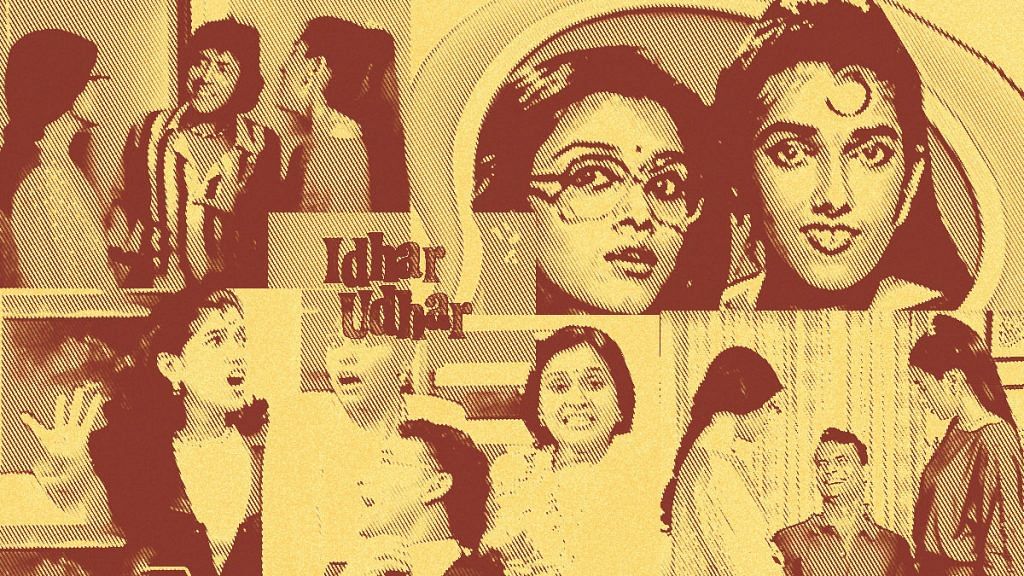Mrs. Bregenza, a Parsi tenant in Bombay, is leaving for Australia to visit her daughter. It falls on her two paying guests, Sunita and Poonam, to look after the house in her absence. The two release an ad in the newspaper stating the requirement of a male paying guest with “dashing appearance and a good sense of humour” so that they are free of all household work. The drama that ensues in the small 2-BHK is comedy gold.
This is the plot of the first episode of Idhar Udhar, a Hindi TV show that first aired in 1985, on Doordarshan. It was directed by Anand Mahendroo and produced by Shobha Doctor. Sunita and Poonam are played by acting veterans and real-life sisters, Ratna Pathak Shah and Supriya Pathak respectively. Ravi Baswani features as Kumar Bhairav/Asif Mohammad Khan/Ronnie Gonsalves and Lilliput (M.M. Farooqui) as Sudhir. The show focuses on what happens when the four live together.
Comedy saved Ratna Pathak Shah
In the show, Sunita played a flight attendant, a profession that was looked down upon and in some cases considered unacceptable, while Poonam was an advertising executive. The characteristics and personas of the two women were poles apart, with Sunita being rather airheaded and Poonam balancing that out by being the pragmatic and responsible adult. Both the female characters are fleshed out and written extremely well, reflecting the real, relatable, and raw struggle of ‘adulting’.
When the show’s director Anand Mahendroo approached Ratna Pathak Shah with both roles, she assumed she would play the sterner Poonam. She tells ThePrint, “Anand came to me with these two characters and I was astounded that he asked me to play Sunita. I was over the moon because that’s something I’ve never done and was just waiting to dive into.”
Her tryst with the genre of comedy, which eventually gave her immortal characters like the snooty Maya Sarabhai in Sarabhai Vs Sarabhai, is known to all. While Idhar Udhar was her first significant paying job, she recalls, “More important than that, it introduced me to comedy, giving me a chance to explore myself as a human being and as an actor. I often say that comedy has saved me as an actor and Idhar Udhar was the first such opportunity.”
Mahendroo initiated this project with Shobha Doctor, but in search of more stability and structure, Sanjeev Sharma and Mansoor Khan of Mobius Productions were approached. “Mansoor also had Scan Video, a post-production house. In those days, it wasn’t as easy as it is now to shoot and edit shows. But we had the resources to produce and post-produce in-house,” Sharma tells ThePrint.
He reminisces, “Television will never be the same. I didn’t go home for three months while we were shooting Idhar Udhar.”
“Anand was very desperate to prove a point that he could do great work. Channeling the phrase ‘dance like it’s your last dance’, we used to produce episodes like it’s our last episode ever,” Sharma says.
After the success of Doordarshan’s Dekh Bhai Dekh, Mahendroo decided to do a second season of Idhar Udhar. Set 13 years later, it had Sunita and Poonam ending up sharing a flat yet again.
Also read: With Ulta Pulta, Jaspal Bhatti spearheaded a brand of sharp political satire
Single people living independently with flatmates (that too, men and women living together platonically), struggling to find an affordable flat, managing work and life as young twenty-somethings made the show not only relatable but also incredibly progressive.
It also portrayed a lifestyle that, in many ways, was only possible and plausible in a city like Bombay — a city built around the idea of work, a transient city where young professionals come and go all the time and live away from their parents, a city where even middle-class people deal with the daily struggle and ragad and don’t really have the time to interfere in other people’s lives. A city where, as Saadat Hasan Manto famously said, “You can do what you want [here]. No one will find fault with you. Nor will anyone subject you to moralising… You may live on the footpath or in a magnificent palace; it will not matter in the least to me.”
The show’s progressive tone is something that one doesn’t see in today’s television, believes Pathak Shah. “Rather than progressing, we are steadily and consistently deteriorating and regressing. Back in the ’80s and ’90s, we were looking ahead rather than looking backwards.”
Idhar Udhar had contemporaries such as Buniyaad, Hum Log, Yeh Jo Hai Zindagi and Tara, all of which were ahead of their time. They had a lot of variety in their storylines and a diverse range of female characters. The glut of saas-bahu dramas and reality TV, though, has changed a lot of that.
Sharma believes, “Back then, television was done for passion, today’s work is done for money.”
However, with the rise of OTT streaming platforms such as Netflix, Amazon Prime Video, Hotstar, Zee5, ALTBalaji and others entering the market, there is a growing space for diversity in content and style, which it is hoped will also lead to a diverse demographic of audiences.
Also read: Fauji: The show that launched a broody, chain-smoking SRK on the path to Bollywood glory
